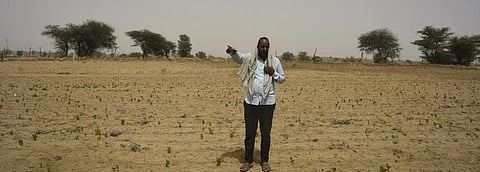

In monetary terms, the crop’s worth is estimate to be Rs 100 million.
“The crop was sown in late April and the locusts have destroyed around 700 hectares of it. On an average, every hectare of land produces around 20 quintals of cotton, that is sold for around Rs 6,000-Rs 7,000 per quintal,” Bikaner Deputy Director, Agriculture Department, Jagdish Poonia told Down to Earth (DTE).
Cotton is one of the main cash crops of the district. Luckily, the sowing of the other major crop of the district, groundnut, hasn’t taken place, saving it from the pests for now.
The district has seen multiple swarms of locusts entering from Pakistan. Bikaner and Jaisalmer are the first districts which the locusts enter. Therefore, the swarms are massive.
One such swarm invaded the cotton fields of Lalawali village in Bikaner’s Chattargarh block near the Sherpura Minor canal. The swarm was five kilometres (km) in width and 10-12 km in length, according to the village residents. It has since moved all the way to Gwalior.
“I was coming back from the market and suddenly, the locusts arrived. It seemed like a dust storm and covered the sun,” Babulal Shashwat, who lost his entire cotton crop on his two- hectare field, said.
The villagers tried to get rid of the locusts by banging utensils and bursting firecrackers.
“When the swarm arrived at 4 pm on May 10, we started bursting crackers and banging utensils to chase them away. The locusts finally left the field around 6 pm,” another farmer, Rajkumar Jhakhad, told DTE.
However, within two hours, the swarm had devoured his 2.5 hectares of cotton crops.
Sowing cotton takes around Rs10,000-Rs 12,000. The farmers have lost that. And the price which the cotton could have fetched. “I have again sown cotton, but now the temperature is too high and the crop is not growing,” Shashwat said.
This isn’t the first time the village has lost a crop to locusts. The insects have attacked every single crop since September 2019.
“I lost a cotton crop in September 2019, then my chana crop in February this year and now this. I am skeptical about sowing groundnut now because people are saying that the locusts will come back again,” Shashwat said.
While on one hand, the farmers are not able to get the price for their crop, on the other, the debt is rising.
“I have a Rs 4.5 lakh loan. But I won’t be able to pay the instalment this year. I haven’t paid the school fees for my children since last year. There’s no money. We survive on the money that my two brothers make working in Bikaner,” Shashwat said.
India is facing the worst locust attacks since 1993. Unseasonal rains in the central and western region countries of the locust-affected areas has led to very high breeding of the pest, according to the Food and Agriculture Organization.